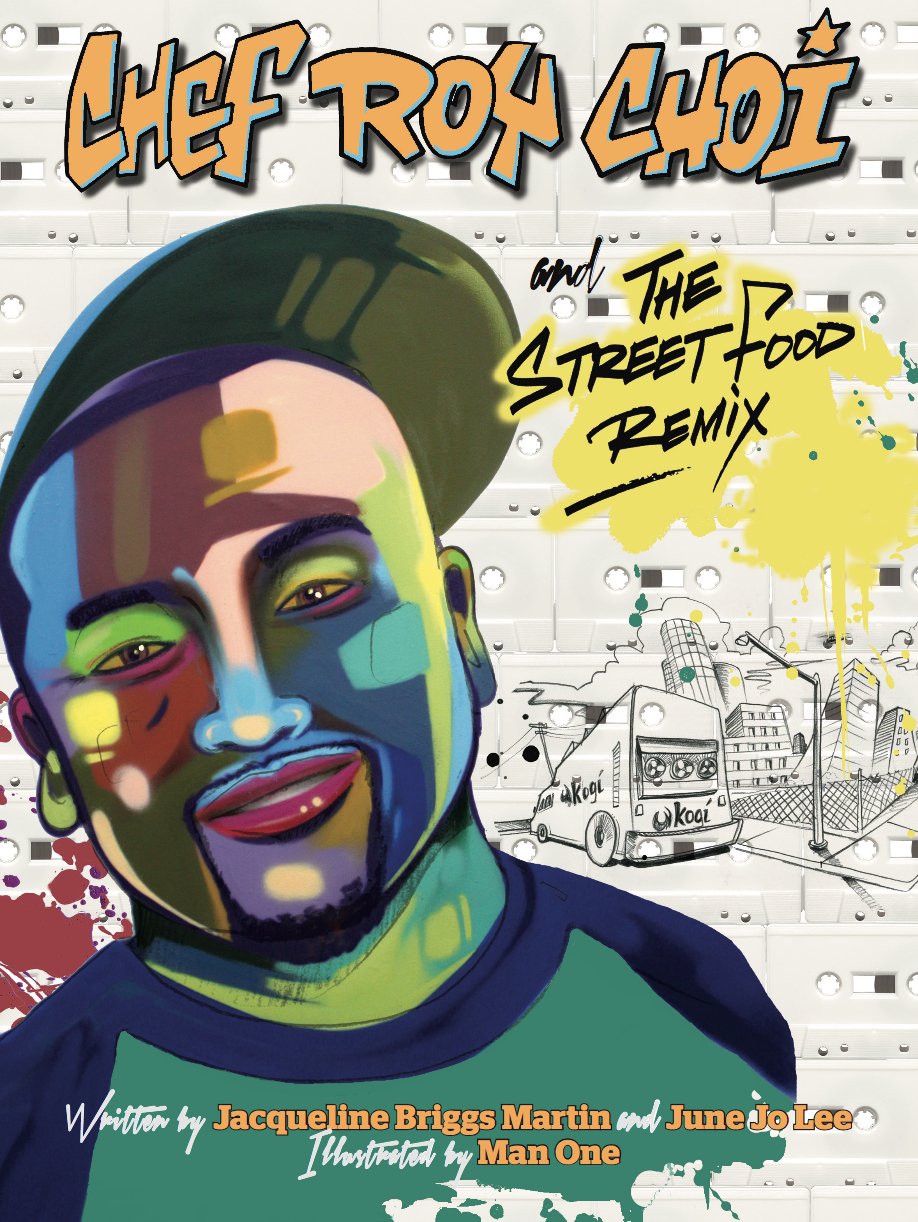By Samantha Pak
Northwest Asian Weekly
 Chef Roy Choi and the Street Food Remix
Chef Roy Choi and the Street Food Remix
Written by Jacqueline Briggs Martin and June Jo Lee, Illustrated by Man One
Readers to Eaters, 2017
As a boy, Roy Choi loved his mother’s cooking. From her tangy kimchi and spicy bibimbap, to her scallion pancakes studded with oysters, his favorite foods were made the Korean way: by hand. He also loved the foods he discovered while exploring the streets of Los Angeles growing up: tamales, tacos, hot dogs, and more.
But no matter how tasty the food was, nothing beat his mother’s Korean cooking.
So when he got older, trying to figure out what to do with his life, the Seoul, South Korea-born Choi went back to his roots and became a chef. He initially worked in fancy restaurants, but that didn’t work out for him. So he and a friend decided to open a taco truck — but with a twist. The tacos they served would feature Korean barbecue and Korean-style fillings.
“Street Food Remix” is a children’s book that tells the story of real-life chef Roy Choi and how he founded the Kogi BBQ Truck in Los Angeles, where his family moved when he was 2.
While this is the story of how Choi overcame professional hardships and opened his own business, it is also the story of how he combined the two cultures of his childhood into something successful. It is the story about how you don’t have to forget any part of yourself in order to be accepted, and how taking that risk to show others every part of you is worth it.
In addition to telling Choi’s story through words, “Street Food Remix” also shows readers his experiences through Man One’s colorful illustrations. As an internationally renowned graffiti artist, Man One’s hip-hop style of work fits in perfectly with the book’s theme of a “remix,” as well as Choi’s journey from his explorations of the streets of Los Angeles to his bringing it back to the streets through his food truck.
 The Leavers
The Leavers
By Lisa Ko
Algonquin Books, 2017
One morning, Deming Guo goes to school like any other day and his mother goes to work at a nail salon. But while Deming comes home at the end of the day, his mother Polly, an undocumented immigrant from China, does not.
Deming doesn’t know where she went and neither do Polly’s boyfriend Leon, nor his sister Vivian. With no trace of his mother, 11-year-old Deming is mystified and bereft.
Eventually, he is adopted by a well-meaning white couple — college professors who move him from his home in the Bronx to a small town in upstate New York.
Deming Guo becomes Daniel Wilkinson, as grows up struggling to assimilate in his new predominately white community and be who his adopted parents want him to be. Ko illustrates the difficulties an individual can go through in trying to belong in a new environment.
“Leavers” is set in New York and China, and told from the alternating perspectives of Daniel as he grows into an aimless young man, and Polly as she has to come to terms with the son she left behind — though not by choice.
With immigration as an ongoing issue in the United States, Ko’s novel shows readers that — even though her characters are fictional — the country’s policies affect real people and real families who often have no control over what happens to them.
Neither Daniel nor Polly are perfect. They have their fair share of flaws, Daniel with his gambling addiction and Polly with her selfishness. But these flaws make them more human and relatable for readers. When characters are relatable, readers are better able to imagine themselves in similar situations.
And if people can find themselves relating to people dealing with immigration issues, it could help them be more understanding in real life, which is not a bad thing.
 Love and Other Consolation Prizes
Love and Other Consolation Prizes
By Jamie Ford
Ballantine Books 2017
Getting the chance to go to the World’s Fair is a special treat for 12-year-old Ernest Young, a half-Chinese orphan and charity student at a Seattle boarding school. Amid the fireworks and Ferris wheels, there are exotic exhibits for visitors to admire. And then he learns that he — a healthy young boy “to a good home” — is actually one of the prizes that people are vying to win.
The winner of the raffle is a flamboyant madam of high-class brothel, who is known for educating her girls.
Ernest becomes the new houseboy and becomes friends with the madam’s daughter Maisie and a scullery maid named Fahn. Having been sent away to the United States at the age of 5, this is the first semblance of any sort of family and sense of home for Ernest. But this doesn’t last forever.
“Love” jumps back and forth between the early 1900s and 50 years later, following Ernest from the time of his arrival in the United States and five decades later as he cares for his ailing wife and struggles to keep family secrets from their adult daughters.
In this book, Ford tells a story about the innocence of young love and the complications that come with love as we grow older. He is a masterful storyteller, seamlessly weaving between the novel’s two time periods to tell Ernest’s story.
And while Ernest is a fictional character, the circumstances of his early life — being raffled off — are based on a true story in which a young boy was given away during the first Seattle World’s Fair. The fact that this was something that actually happened is mind boggling and it is only natural to wonder who that boy was and what happened to him. Ford’s “Love” offers readers one possibility.
Samantha can be reached at info@nwasianweekly.com.



